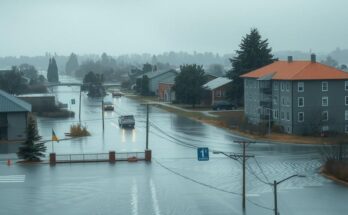Hurricane Rafael has intensified into a Category 3 storm with 120 mph winds but is moving away from Florida. It is expected to weaken as it travels through the Gulf of Mexico. Swells from the storm may create dangerous surf conditions on the Gulf Coast. Residents should remain informed about its progress and potential impacts.
The National Hurricane Center has reported that Hurricane Rafael has intensified into a Category 3 storm with sustained winds reaching up to 120 mph. Although the storm poses significant threats due to its strength, current forecasts suggest that it is taking a track away from Florida and the U.S., meandering through the Gulf of Mexico where it is expected to gradually weaken over the coming days. A trough of low pressure near Puerto Rico is responsible for producing heavy rainfall and thunderstorms in the vicinity, although it currently possesses a low likelihood of developing into a significant storm. Hurricane Rafael caused substantial damage in western Cuba, including the disruption of the island’s electrical grid, before it reintensified. Meteorologists from AccuWeather indicate that Rafael is being pushed westward by a mid-level ridge and is likely to experience increasing wind shear, which will lead to a gradual decrease in wind intensity. As the storm continues to move, swells generated by Rafael are anticipated to create hazardous surf and dangerous rip current conditions along the Gulf Coast for the upcoming days. It is crucial for those in the southern and southwestern Gulf of Mexico to stay informed regarding the storm’s trajectory. The next named storm on the Atlantic hurricane season roster will be Sara. As of the latest update from the National Hurricane Center, the storm’s coordinates are 24.5N 88.0W, approximately 245 miles north-northeast of Progreso, Mexico, and 585 miles east of the mouth of the Rio Grande, with a minimum central pressure recorded at 956 mb. Residents are advised to remain vigilant in monitoring Hurricane Rafael’s developments, particularly concerning potential impacts in Florida where hazardous surf conditions are expected. Although forecasters believe the storm’s current trajectory will spare the central Gulf region from severe weather impacts, local heavy rains could still occur in the northern Leeward Islands and the Virgin Islands. Therefore, authorities recommend continuous monitoring of the tropical systems, especially with the season running from June 1 to November 30.
Hurricane Rafael is the latest natural phenomenon to emerge during the Atlantic hurricane season, which spans from June 1 to November 30. The National Hurricane Center (NHC) utilizes forecasting models, known as spaghetti models, to predict the path and intensity of storms, although these models can vary in accuracy. Hurricanes like Rafael can pose significant risks to coastal areas due to their capacity to generate strong winds, heavy rainfall, and dangerous surf conditions. The dynamics of tropical weather systems, including wind shear and mid-level ridges, are critical in understanding storm behavior and potential impacts on land. This specific storm not only caused damage previously in Cuban territory but also poses risks of severe weather activity across the Gulf of Mexico.
In summary, Hurricane Rafael has intensified into a Category 3 storm but is taking a trajectory away from the U.S., particularly Florida, where the threat of severe impacts appears reduced. Meteorological observations indicate Rafael will likely weaken due to increased wind shear while generating hazardous surf conditions along the Gulf Coast. It remains vital for residents in affected areas to stay updated on storm developments and prepare for possible changes, while also monitoring other weather systems within the Atlantic region.
Original Source: www.news-press.com



